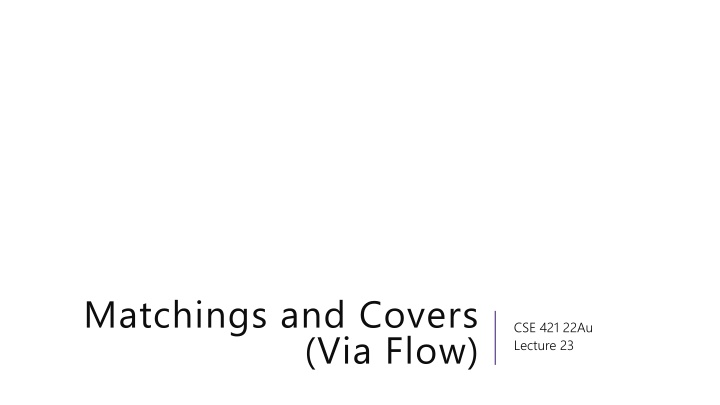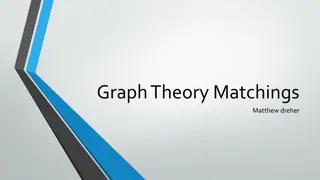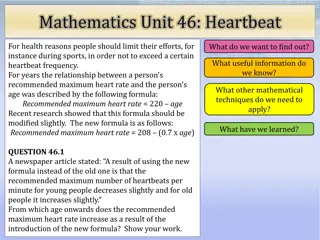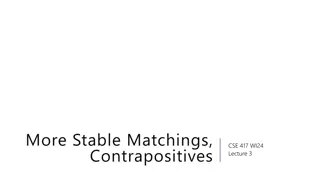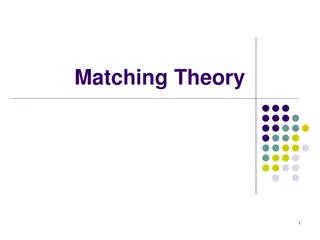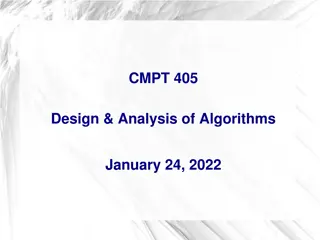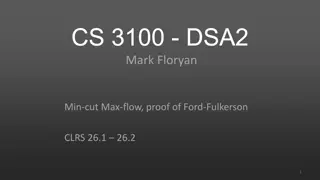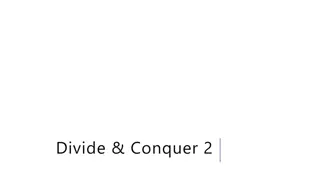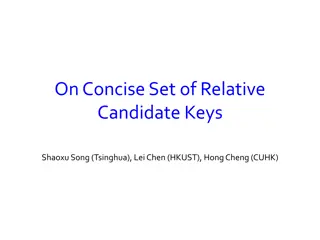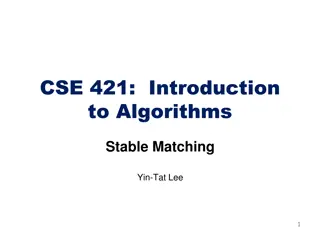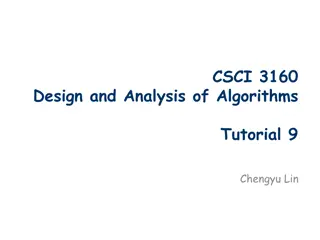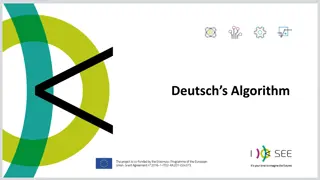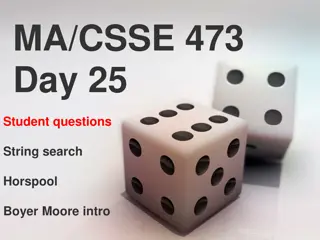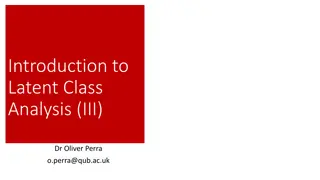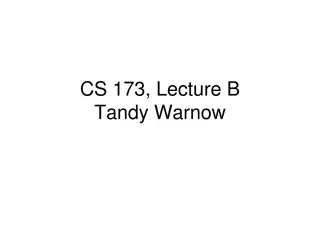Bipartite Maximum Matching Algorithm
In this lecture, we delve into the concept of maximum matching in bipartite graphs. We explore the algorithmic approach to finding the maximum matching using dummy sources and sinks, along with directed edges to optimize the process. The step-by-step explanation with visual aids simplifies the understanding of this key graph theory problem.
Uploaded on Feb 16, 2025 | 0 Views
Download Presentation

Please find below an Image/Link to download the presentation.
The content on the website is provided AS IS for your information and personal use only. It may not be sold, licensed, or shared on other websites without obtaining consent from the author.If you encounter any issues during the download, it is possible that the publisher has removed the file from their server.
You are allowed to download the files provided on this website for personal or commercial use, subject to the condition that they are used lawfully. All files are the property of their respective owners.
The content on the website is provided AS IS for your information and personal use only. It may not be sold, licensed, or shared on other websites without obtaining consent from the author.
E N D
Presentation Transcript
Matchings and Covers CSE 421 22Au Lecture 23 (Via Flow)
Today One last day of max-flow. Two new problems we can solve with max-flow/min-cut. Today s proofs are short but subtle; I m intentionally taking us through slowly. Please ask questions.
A (possibly) simple problem Given a bipartite graph, find a maximum matching. A matching matching is a set of edges that do not share an endpoint. Think of it as matching the endpoints of the edges to each other. A stable matching is a particular matching on a complete bipartite graph.
A (possibly) simple problem Given a bipartite graph, find a maximum matching. A matching matching is a set of edges that do not share an endpoint. For example, on this graph the red edges are a maximum matching. There is no way to get 4 edges in a matching.
A (possibly) simple problem Design an algorithm to find a maximum matching on a bipartite graph. (hint: what if the vertices on one side are chores and the other are housemates).
Algorithm for Bipartite Maximum Matching Use the tuple selection/assignment we did last week!
Algorithm for Bipartite Maximum Matching Add a dummy source and sink. Attach each to one side.
Algorithm for Bipartite Maximum Matching Add a dummy source and sink. Attach each to one side. Direct (previously undirected) edges toward sink
Algorithm for Bipartite Maximum Matching Add a dummy source and sink. Attach each to one side. Direct (previously undirected) edges toward sink. Capacity 1 entering and leaving each (real) vertex ensures matching ?/1 ?/1
Algorithm for Bipartite Maximum Matching Add a dummy source and sink. Attach each to one side. Direct (previously undirected) edges toward sink. Capacity 1 entering and leaving each (real) vertex ensures matching Capacity in the middle (it ll help later) ?/ ?/1 ?/1
Algorithm for Bipartite Maximum Matching Add a dummy source and sink. Attach each to one side. Direct (previously undirected) edges toward sink. Capacity 1 entering and leaving each (real) vertex ensures matching Capacity in the middle (it ll help later) ?/ ?/1 ?/1
Algorithm for Bipartite Maximum Matching Add a dummy source and sink. Attach each to one side. Direct (previously undirected) edges toward sink. Capacity 1 entering and leaving each (real) vertex ensures matching Capacity in the middle (it ll help later) Red edges have flow. Take edges with flow for the matching. ?/ ?/1 ?/1
Algorithm for Bipartite Matching Modify the (undirected) graph ? into the network flow graph. Find a maximum flow, taking all edges of ? which have flow. Is it correct? The set of edges found should be a matching. There should be no larger matching.
Algorithm for Bipartite Matching Modify the (undirected) graph ? into the network flow graph. Find a maximum flow, taking all edges of ? which have flow. Is it correct? The set of edges found should be a matching. Capacities ensure no edge has more than one unit of flow through it. By integrality of flow, we have only one edge. There should be no larger matching. Suppose, for contradiction, that ? is a larger matching, then put a unit of flow on ?, entering each vertex with an endpoint in ? on the left and leaving on the right. This is a valid flow! But then its value is |?|, which would be larger than the max-flow, a contradiction.
Solving a new problem (with matchings) Let ? be an undirected graph. A minimum vertex cover is the smallest set of vertices such that every edge has at least one of its endpoints in the set. Here s an[other] algorithm to find a minimum vertex cover in a bipartite graph
Vertex Cover How to find a vertex cover? Well a max-flow says you can t use this edge; (at least) one of its endpoints is already used by the matching. Here s a vertex cover (in gold). Notice something about it? ?/ ?/1 ?/1
Vertex Cover Here s a vertex cover (in gold). Find the min-cut (write residual graph) ?/ ?/1 ?/1
Vertex Cover Flow graph ?/1 ?/ ?/1 Residual; Cut in blue X s
Vertex Cover How to find a vertex cover? Well a max-flow says you can t use this unsaturated edge; (at least) one of its endpoints is already used by the matching. Here s a vertex cover (in gold). Notice something about it? It looks a lot like the min cut. ?/ ?/1 ?/1
Vertex Cover Let ? be the left bipartition, ? the right side. Let (?,?) be the min-cut. ??= ? ?;??,??,?? defined correspondingly. Here, ?? and ?? form a vertex cover ?/ ?/1 ?/1
Vertex Cover Is ?? ?? always There are 4 potential kinds of edges. Which kind is a problem for the vertex cover? Can they all exist? ?? to ?? ?? to ?? ?? to ?? ?? to ?? ?/1 always a vertex cover? If so, how big is it? ?/ ?/1
Vertex Cover Is ?? ?? always There are 4 potential kinds of edges. Which kind is a problem for the vertex cover? Can they all exist? ?? to ?? ?? to ?? ?? to ?? ?? to ?? ?/1 always a vertex cover? If so, how big is it? Only kind we have to worry about!! But you can t have an edge from ? to ?! We have a vertex cover. ?/ ?/1
Vertex Cover How big is ?? ??? Well, it looks a lot like the min-cut. ?,?? and (??,?) are cut. Each of those edges is capacity 1. Each has an endpoint we put in the vertex cover! ?? ?? = cap ?,? = |?|. ?/ ?/1 ?/1
But is it a minimum VC? So it s a vertex cover, of size equal to the min-cut what if there s a smaller vertex cover? Let ? be any vertex cover, define ??,BX as before.
No smaller VC Let ? be any vertex cover, define ??,BX as before. Claim: ( ? ?? (? ??), ? ? ?? ??) is a cut with cut edges are ?,??,(??,?). [this is the corresponding cut to before] ?/ ?/1 ?/1
But is it a minimum VC? So it s a vertex cover, of size equal to the min-cut what if there s a smaller vertex cover? Let ? be any vertex cover, define ??,BX as before. Claim: ( ? ?? (? ??), ? ? ?? ??) is a cut with cut edges are ?,??,(??,?). No (? ??), (? ??)edges because we re a cover!
No smaller VC Every vertex cover lets you discover a cut of the same size. Our algorithm found a VC of size equal to the minimum cut! A smaller VC would give a smaller cut! But there isn t one. So we have found the min VC. ?/ ?/1 ?/1
Wrapping it up You can find the following of a bipartite graph (using only flow) 1. Maximum matching 2. Minimum Vertex cover And their value is equal to the size of the max-flow (and the min-cut) in the modified graph. K nig sTheorem (aka K nig-Egevary Theorem) In a bipartite graph, the size of the maximum matching is equal to the size of the minimum vertex cover.
Wrapping It Up We ve found maximum matchings and minimum vertex covers in bipartite graphs using flow. If your graph isn t bipartite: Efficiently finding a maximum matching is still possible. but more complicated. Look up Edmond s Blossom Algorithm Efficiently finding a minimum vertex cover, is a taller task. It s an NP-complete problem. We ll more clearly define what that means and
But Wait, Theres More Applications! Finding Edge disjoint paths in a directed graph. Maximum number of paths from ? to ?that don t repeat an edge. I want to send a packet from ? to ? but edges are unreliable. Want completely independent copies. Finding internally-vertex-disjoint paths in a directed graph Send packet, but I don t trust the vertices. Image Segmentation A surprisingly useful tool for matching and separating things. Also for proving graph theory results (Konig-Egevary, Hall s Theorem)
